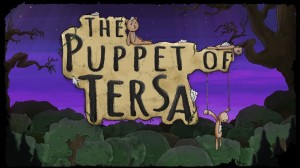Review for Sumatra: Fate of Yandi

With its retro presentation and mappable environment, Cloak and Dagger Games’ Sumatra: Fate of Yandi feels like an old-school Sierra game but with the rough edges of sudden death and dead ends sanded off and a greater focus on character added on. Set in a tropical rainforest on the island of Sumatra in the fall of 2018, the titular character has to deal with acts of nature, hostile wildlife, wandering nomads, and even a conspiracy or two, which all makes for an enjoyable if somewhat easy outing.
Yandi is just trying to make a living for himself and his wife Adiratna by working for Pandang Logging, which in the past few months has come under new management that hasn’t been paying its staff. Understandably this has caused friction both at work and at home, but that’s nothing compared to what awaits Yandi as he and his brother-in-law Ramdam are sent out for a job with nicely animated rain streaming down. In short order the two are caught in a landslide and separated, with Yandi being washed down a river and stranded somewhere in the jungle. With poor reception and failing batteries for his radio, Yandi can’t call for help so he must instead brave the wilds to try to return to civilization.
Even before that, Sumatra gets off to a fun start from the get-go. An inset on one side of the main menu shows Yandi driving through the rain on his motorbike. Starting a brand new game causes the rest of the menu to fade out and Yandi’s own background scene to fade in, from which he drives into the beginning of the story. It seems like a simple thing, but the transition into the game proper is a clever little touch that really put a smile on my face.
The adventure is split up into three informal acts. Early on, Yandi must make his way through a linear stretch of forest and get past a vicious and hungry looking tiger in the aftermath of the rain storm. This section serves to introduce the basic gameplay mechanics, which is all pretty straightforward with left-click to interact and right-click to examine. You can also collect items that are stored in an inventory bar made visible by moving the cursor to the top of the screen. When an object from the inventory is selected, the mouse pointer changes to resemble it, helpfully incorporating a red dot to indicate the precise location that will actually interact with hotspots.
After finishing the initial tutorial stretch, Yandi falls into a delirium and is found by a handful of wandering nomads who take him to their temporary village. This second act forms the bulk of the game. Naturally the villagers have no way of contacting civilization, and what’s worse for Yandi, the kids here have completely worn down the batteries for his radio and the elders have taken his axe, a vital tool for getting out of the jungle. These nomads treat all trees as sacred and look on Yandi, as a logger, with distaste. In order to gain their favour, you must perform a series of tasks for various members of the tribe.
These objectives mostly amount to fetch quests: retrieve water from a stream in a jug full of holes, find a lost boy, gather various important plants and the like. However, as they are introduced specifically to raise Yandi’s standing, it all feels natural to the plot instead of just busywork. Most of the tasks are layered, which helps differentiate them from simply picking up an item and returning it. As a simple example, you’ll have to figure out how to plug the holes in that water jug before you can transport any water in it. And forget about using a different jug, as the woman who sets the goal is very particular about the leaky jug being used because she knows that it will be more difficult for Yandi.
With the village as your starting point, you’ll wander through the jungle accomplishing your assignments, where I got a really strong King’s Quest IV or Space Quest III vibe. The pixel art backgrounds have those same clean, large blocks of colour that were prevalent in the 16-colour EGA graphics of those early Sierra titles. However, Sumatra takes advantage of the full spectrum of colours so no eye-searing neon greens, yellows, or pinks here. To add more texture, a subtle film grain overlays everything, providing a faint effect that is never distracting but instead helps to liven up the scenes by making them seem more animated than they otherwise would be. Of course, other animations are also present with drifting clouds, running waterfalls, flying insects, and smooth parallax scrolling.
Despite predominantly taking place within the jungle, Sumatra has a surprising amount of variety in its locales. There are caves to explore, the nomad village to roam, rivers to ford, the high branches of a tree to climb, and some melancholy scenes of a former swath of the rainforest that has been clear cut to mourn over. Flashbacks throughout the game also provide glimpses into Yandi’s home and workplace. Even the “generic” jungle scenes are usually brightened with vibrant flora or fauna.
It’s not just the background style that is reminiscent of Sierra either. The characters do as well, displaying a simple look that lacks any real facial features like eyes or mouths. I did feel that a bit more work could have gone into the sprites, as the simple blocks of colour used to design them tended to make more than a few of them look alike. Even so, they possess a good amount of animation, especially Yandi, who has to climb, jump, swim, vine swing, and check his radio at various points.
Continuing the Sierra-esque trend, the environs surrounding the village are arranged in classic room-by-room tile fashion. Exiting the left side of one scene enters the immediate right side of the next. Leaving through the bottom enters the adjacent setting through the top. While the jungle’s not a maze, it does lend itself to mapping with pencil-and-paper, which is something I greatly enjoy and have felt is missing in a lot of modern adventures. (Ah, nostalgia for an earlier time!) If you do map the jungle, it’s helpful to jot down where different items and features are located, as many of the puzzles involve bits and pieces from all over.
Even with certain items spread out across the forest, the level of difficulty in this adventure is definitely on the easier side. I only encountered two scenarios that were particularly challenging in my 3½ hour play time. The first involved trading with a man for a lighter that, unless I missed a key clue somewhere, simply requires trying everything on him until he accepts something. And then there was a specific area in a darkened cave that I overlooked for some time. Once I found it, the puzzle itself was easily solved.
Eventually Yandi gets his axe back, which signifies the start of the third act where he must try to return to civilization. At this point he comes across a bunker set up by a research expedition that might help him get home. The only problem is, none of the researchers are around. Here the game shifts from a simple story about doing what’s necessary to get home into more of a mystery, as Yandi has to uncover what happened to the team and how it might tie into his own situation. To say more would risk delving into spoiler territory, and as the story in this section is one of the game’s strengths, that would be doing it an injustice.
Not only does the narrative layer on a few nice twists to keep things fresh and moving along, the characters also tend to be more developed than usual for this type of game. Through a series of flashbacks, Yandi’s history is explored, ranging from meeting his future wife Adiratna, the relationship with his best friend, and the difficulties he’s been having under the new management at the logging company. As well, Yandi is revealed to be far from the greatest climber or particularly fond of swimming, and yet he has to tackle both in his travels. I wouldn’t have minded seeing these latter character flaws dealt with in a bit more detail, but they were nice additions nonetheless.
I also enjoyed getting to know Yandi’s brother-in-law and stalwart friend Ramdam. Seeing him in the flashbacks helped me sympathize with the protagonist, who is uncertain of Ramdam’s fate after the two are separated in the landslide. Kevin, the baseball cap-wearing spokesperson of the villagers, is another fun character who can translate for Yandi and is sympathetic to his desire to leave the jungle. It’s refreshing to encounter someone who is pleasant and helpful in a game without demanding players do something to help him first.
Overall Sumatra does a good job of unveiling its tale organically. I very much found myself wanting to keep playing to see what would happen next, and it all works really well right up until the ending. But here the game reverses its earlier tendency to show and not tell. The resolution is presented via a rather obnoxious talk show host who could easily have been named Mr. Exposition. Although he spells out everything that happens to wrap things up, I walked away feeling like I’d missed out on something more personal. Imagine watching a really good movie and then stepping away ten minutes before it ends and having your friends tell you how it finished. That’s the vibe here. Even so, the rest of the game is good enough that I can just about forgive this lapse in storytelling at the finish line.
In keeping with the nostalgic feeling, the audio too feels reminiscent of old Sierra games, or at least old Sierra games if they had access to modern technology. Music is only occasionally used at key points and has an almost MIDI-style feel but sounds a bit warmer. The few riffs played are appropriately jungle adventure-y, especially the tense theme used when encountering the tiger. When the score isn’t providing accompaniment, low-level rainforest ambience is abundant: wind blows, birds chirp, and insects buzz.
Conversation is completely unvoiced, with spoken lines displayed as text above the characters’ heads. These do not auto-progress when finished, instead requiring a mouse click to move ahead to the next. A few dialog trees are incorporated, with options listed in white at the bottom of the screen. Topics are either removed or turned green when exhausted. This tripped me up on a couple of occasions, however, as broader options, once asked, will turn green and stay green even if they lead to subsequent branches that have not been explored yet. I found myself missing a couple of new subjects simply because they were buried in a set of choices beyond a selection already marked as complete.
Despite being trapped in a jungle with perils abounding, there is never any risk of death here to cause a loss of progress. Nor did I ever encounter any situation where a needed item was beyond my ability to attain. Even so, I was quite pleased to see the presence of a full save game system, allowing me to record as many saves as I liked with their own file names.
Although a fairly light outing, Sumatra: Fate of Yandi is an enjoyable one with charming characters and an intriguing story. Its lost-in-a-jungle premise has a nice adventure feel in the traditional sense of the word, and fans of classic Sierra games will surely appreciate the nostalgic pull of the presentation, though even those unfamiliar with such titles will find much to like here. The ending is undeniably weak, but the rest of the tale certainly makes up for it, delivering a fun little adventure to lose yourself in for a few hours.
Our Verdict:
Evoking the feel of classic Sierra games but without their sudden deaths and dead ends, Sumatra: Fate of Yandi is a fun, enjoyable tale of survival in a lush rainforest, only marginally brought down by a weak ending.































